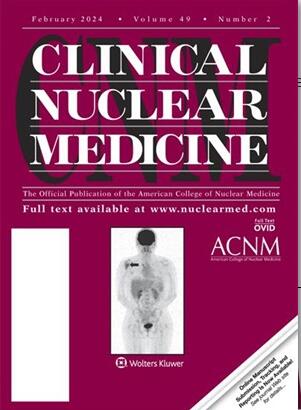18F-FDG半导体PET/CT检测高松动脉炎动脉闭塞为血池缺损。
IF 9.6
3区 医学
Q1 RADIOLOGY, NUCLEAR MEDICINE & MEDICAL IMAGING
Clinical Nuclear Medicine
Pub Date : 2025-05-01
Epub Date: 2025-02-11
DOI:10.1097/RLU.0000000000005701
引用次数: 0
摘要
摘要:一名75岁女性高须动脉炎患者因实验室数据中c反应蛋白升高而接受18F-FDG PET/CT检查。FDG PET/CT与半导体检测器显示动脉壁未见摄取,提示活动性炎症。然而,左锁骨下动脉近端部分的血池摄取有缺陷,提示动脉闭塞。磁共振血管造影显示左锁骨下动脉完全闭塞。超声显示左椎动脉逆流。半导体PET可以显示动脉分支动脉内摄取的血池缺陷。本文章由计算机程序翻译,如有差异,请以英文原文为准。
Arterial Occlusion in Takayasu Arteritis Detected as a Blood Pool Defect on 18 F-FDG Semiconductor PET/CT.
Abstract: A 75-year-old woman with Takayasu arteritis was referred to 18 F-FDG PET/CT due to elevated C-reactive protein in her laboratory data. FDG PET/CT with semiconductor detectors revealed no uptake in the arterial walls, suggesting active inflammation. However, the blood pool uptake in the proximal portion of the left subclavian artery was defective, suggesting arterial occlusion. Magnetic resonance angiography revealed complete occlusion of the left subclavian artery. Ultrasonography showed the reverse flow of the left vertebral artery. Semiconductor PET can visualize the blood pool defects of the intra-arterial uptake in the arterial branches from the aorta.
求助全文
通过发布文献求助,成功后即可免费获取论文全文。
去求助
来源期刊

Clinical Nuclear Medicine
医学-核医学
CiteScore
2.90
自引率
31.10%
发文量
1113
审稿时长
2 months
期刊介绍:
Clinical Nuclear Medicine is a comprehensive and current resource for professionals in the field of nuclear medicine. It caters to both generalists and specialists, offering valuable insights on how to effectively apply nuclear medicine techniques in various clinical scenarios. With a focus on timely dissemination of information, this journal covers the latest developments that impact all aspects of the specialty.
Geared towards practitioners, Clinical Nuclear Medicine is the ultimate practice-oriented publication in the field of nuclear imaging. Its informative articles are complemented by numerous illustrations that demonstrate how physicians can seamlessly integrate the knowledge gained into their everyday practice.
 求助内容:
求助内容: 应助结果提醒方式:
应助结果提醒方式:


